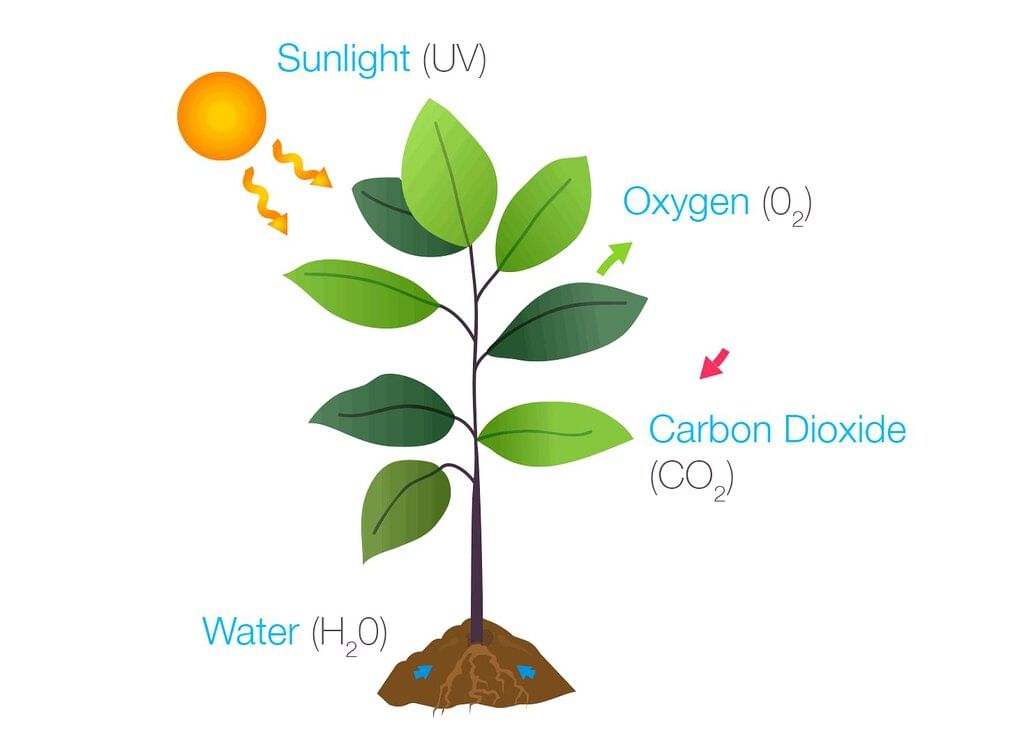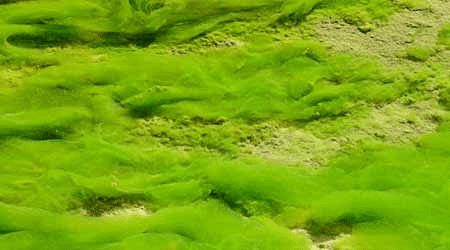Photosynthesis: Food Making Process in Plants | Science Class 7 PDF Download
Imagine leaves as the kitchen factories of plants. Just like we need food to survive, plants need food too, but they make it themselves! The leaves are like little chefs that cook up food for the plants.
 Leaves: Chef for PlantsBut in order for the leaves to do their job, they need all the necessary ingredients. Just like when we cook, we need to gather all the ingredients from the pantry, and the leaves need to get their ingredients from the rest of the plant.
Leaves: Chef for PlantsBut in order for the leaves to do their job, they need all the necessary ingredients. Just like when we cook, we need to gather all the ingredients from the pantry, and the leaves need to get their ingredients from the rest of the plant.
These ingredients are water and minerals, which are found in the soil. The roots of the plant act like little straws, sucking up the water and minerals from the soil and sending them up to the leaves. Once the leaves have all the ingredients they need, they can start making food for the plant!
Process of making food in Green Plants: Photosynthesis
Leaves possess chlorophyll, a green pigment that aids in capturing sunlight's energy and gives color to the leaves. This energy is utilized to produce food by combining carbon dioxide and water. As this food synthesis process relies on sunlight, it is known as photosynthesis.
Definition of Photosynthesis: The process of making food by green plants in the presence of sunlight and chlorophyll is known as photosynthesis.
Photosynthesis is the combination of two words- Photo + Synthesis. ‘Photo’ means light and ‘Synthesis’ means to make.
 Green plants make their food through PhotosynthesisOur earth is the only unique planet where photosynthesis takes place. In the absence of photosynthesis, life would not be possible on earth.
Green plants make their food through PhotosynthesisOur earth is the only unique planet where photosynthesis takes place. In the absence of photosynthesis, life would not be possible on earth.
Following are necessary for photosynthesis to take place:
Hence, for taking place of photosynthesis carbon dioxide, water, and sunlight must be present in the green leaves in addition to the presence of chlorophyll. Leaves have several tiny pores on their lower surface. These are called stomata, through which leaves absorb carbon dioxide from the air.
Let's understand the Plant's Nose:
What is Stomata?
- Plants have special tiny openings on their leaves called stomata. These stomata act like little doors that let the plant take in something very important for its survival: carbon dioxide from the air. Just like we breathe in oxygen, plants breathe in carbon dioxide.
- These stomata are like the plant's nose, and they are surrounded by special cells called guard cells that protect and control the opening and closing of the stomata.
 Stomata
Stomata
So, the stomata are like little windows that help the plant get the carbon dioxide it needs to survive.
- After absorbing CO2, water is transported to the leaves through hair-like pipelines from the roots. These pipelines are present throughout the plant, i.e., from roots to branches and leaves.
Let's understand how Roots send water to leaves?Think of plants like a big network of pipes that carry water and minerals to all parts of the plant, including the leaves. These pipes are called vessels, and they run through the roots, stems, branches, and leaves just like pipes run through a building.
They create a pathway for the water and minerals to travel and reach the leaves. So, it's like the plant has its own plumbing system to deliver all the important nutrients to every part of its body.
- These pipelines are known as Xylem. Xylem is a type of tissues.
 Xylem: Works as pipeline for plants
Xylem: Works as pipeline for plants
- Chlorophyll, a green pigment, is found in green leaves. Chlorophyll absorbs sunlight and gives energy. Chlorophyll absorbs sunlight, carbon dioxide and water and convert them to carbohydrate and oxygen. Carbohydrate is used as food and oxygen is emitted out to the atmosphere.
- This whole process of making food by plants is called photosynthesis.
 Complete process of Photosynthesis
Complete process of Photosynthesis
- The reaction that takes place in the process of photosynthesis can be written as:


- Carbohydrate which is produced in the process of photosynthesis is ultimately converted into starch and stored into leaves. From leaves, it is transported to the parts of plants. Starch is a type of carbohydrate. The oxygen so produced is released into the atmosphere through the stomata.
- Besides leaves, photosynthesis takes place in other green parts of the plant also, such as in green stems. Chlorophyll is necessary for photosynthesis; hence photosynthesis takes place only in green plants.
- The leaves of plants that grow in desert areas are modified in spine-like structure or scales to reduce the loss of water in the course of transpiration. In such plants, photosynthesis takes place in green stems.
- Photosynthesis helps to maintain a balance between oxygen and carbon dioxide in the atmosphere as it absorbs carbon dioxide and release oxygen.
- Sunlight is necessary for photosynthesis. Thus, the sun is the ultimate source of energy for all living organism.
Photosynthesis in Algae
 Photosynthesis in Algae
Photosynthesis in Algae
- Green patches in ponds or near stagnant water can be seen easily. These green patches are living organism called algae.
- Algae are plants. Often algae grow near the shallow waterlogged areas such as near tube wells, taps, etc. One may slip over it. Algae look green because of the presence of Chlorophyll. Algae prepare their own food by the process of photosynthesis.
Synthesis of Plant Food Other Than Carbohydrates
- Plants need proteins and fats besides the carbohydrate. Proteins are nitrogenous substances which contain nitrogen.
- Although nitrogen is present in abundance in the atmosphere, but plants cannot absorb atmospheric nitrogen. plants get nitrogen from the soil.
- Certain types of bacteria called rhizobium, are present in the soil. They convert gaseous nitrogen into usable form and release it into the soil. Plants absorb these soluble forms of nitrogen along with water and other minerals through their roots.
- Sometimes farmers add nitrogenous fertilizer to their field to fulfil the need of nitrogen. In this way, plants get the fulfilment of nitrogen along with other nutrients. After the fulfilment of all nutrients plants synthesises proteins and fats.
|
111 videos|246 docs|28 tests
|
FAQs on Photosynthesis: Food Making Process in Plants - Science Class 7
| 1. What is photosynthesis? |  |
| 2. What are the other types of plant food synthesized during photosynthesis? |  |
| 3. How does photosynthesis benefit the environment? |  |
| 4. What factors can affect the rate of photosynthesis in plants? |  |
| 5. How do scientists study photosynthesis in plants? |  |

|
Explore Courses for Class 7 exam
|

|


















